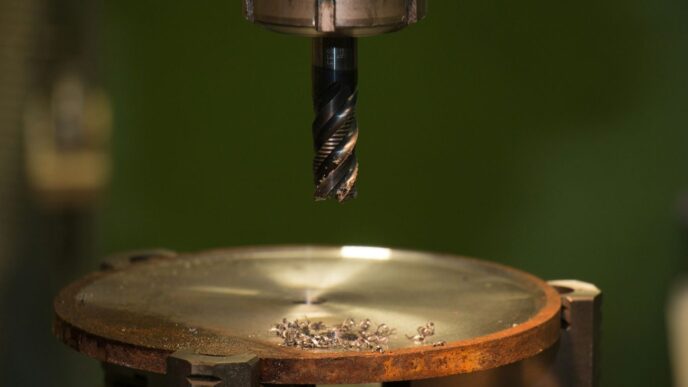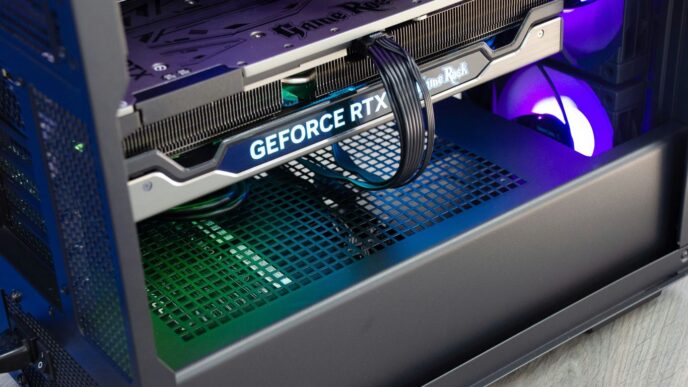Looking for the top silicon carbide (SiC) wafer suppliers for 2025? You’ve come to the right place. SiC technology is really taking off, powering everything from electric cars to faster internet. It’s a bit tricky to figure out who’s who in this growing market, though. That’s why we’ve put together this guide to help you understand the major players. We’ll cover the companies making waves in the SiC wafer world, giving you a clear picture of what they offer and why they matter.
Key Takeaways
- The demand for SiC wafers is growing fast, mainly because of electric vehicles and renewable energy projects.
- SiC technology allows for more efficient and smaller electronic devices compared to traditional silicon.
- Companies are working on making bigger, better SiC wafers to lower costs and improve performance.
- Partnerships between car makers and SiC suppliers are becoming common to ensure a steady supply.
- While SiC offers great benefits, its higher manufacturing costs and supply chain limits are still challenges to watch.
1. Wolfspeed Inc
When you talk about silicon carbide (SiC) wafers, Wolfspeed is a name that comes up a lot. They’ve been around for a while, originally known as Cree, and they’ve really put a lot of effort into SiC technology. It’s not just about making the wafers themselves; they also make devices and modules that use SiC. Think about electric cars – Wolfspeed’s stuff is used in things like inverters, which are pretty important for how those cars run. They’re also involved in solar power systems and fast chargers.
It seems like they’re always working on making their SiC technology better, trying to get more efficiency out of it. That’s a big deal because SiC is known for being tough and handling high temperatures, which is exactly what you want for power electronics.
Here’s a quick look at what they focus on:
- SiC Wafers: The basic building blocks for all SiC devices.
- EV Inverters: Key components for electric vehicles.
- Solar Inverters: Used in renewable energy systems.
- Ongoing Research: They keep investing in R&D to improve SiC performance.
2. Coherent Corp
Coherent Corp. is another big name in the silicon carbide (SiC) wafer game. They’ve been around for a while, building up their capabilities in materials science, which is pretty important when you’re dealing with something as specialized as SiC.
They’re known for their work in photonics and lasers, but they’ve really pushed into the semiconductor materials space, including SiC. It’s not just about making the wafers; it’s about the quality and consistency, which is what Coherent seems to focus on. They’re involved in different parts of the supply chain, which can be a good thing for stability.
Here’s a quick look at some of the areas they’re involved in:
- Materials Science Expertise: They have a strong background in developing and manufacturing advanced materials, which is a direct benefit to their SiC wafer production.
- Broad Product Portfolio: While SiC wafers are a focus, their wider involvement in optical and electronic materials means they can potentially integrate different technologies.
- Global Presence: Like many of the top players, Coherent operates on a global scale, which is necessary to serve the worldwide demand for these advanced materials.
Coherent’s commitment to material innovation positions them as a significant supplier for the growing SiC market. They’re definitely a company to watch as the demand for high-performance semiconductors continues to climb.
3. STMicroelectronics NV
STMicroelectronics NV, often just called STM, is a big player in the semiconductor world, and they’re definitely making waves in the silicon carbide (SiC) wafer market. They’re not just sitting back; they’re actively working on improving their SiC production. A major move they’re making is transitioning their SiC wafer production to 8-inch wafers. This is a pretty significant step because it’s expected to make things more efficient and give them a cost edge over competitors who are still using older 6-inch wafer technology.
STM offers a range of SiC semiconductor devices, including SiC MOSFETs and power modules. These are designed for various applications, especially in the automotive sector, with a particular focus on electric vehicles (EVs) and industrial uses. They’ve been teaming up with major car manufacturers to really fine-tune their power electronics, which is a smart move given how fast the EV market is growing.
It’s clear that STM is putting a lot of effort into R&D to boost SiC efficiency. They’re aiming to provide solutions that are not only high-performing but also energy-efficient and compact, which is exactly what the market is looking for right now. Their commitment to advancing SiC technology means they’re a company to watch as the demand for these advanced materials continues to climb. You can find more details about their strategic positioning in the semiconductor market on their company website.
4. SK Siltron Co Ltd
SK Siltron, a South Korean company, is a significant player in the silicon carbide wafer market. They’ve been building up their capacity and technology, aiming to be a top supplier for the growing demand in power electronics.
SK Siltron is known for its focus on producing high-quality SiC wafers, particularly for high-power applications. They are investing in expanding their manufacturing capabilities to meet the needs of the automotive and renewable energy sectors, which are big users of SiC technology.
Here’s a quick look at some of the areas they focus on:
- Wafer Production: They make SiC wafers, which are the base material for SiC devices. The quality of these wafers really matters for how well the final chips perform.
- Technology Development: SK Siltron is working on improving their crystal growth and wafer processing techniques. This includes things like making larger diameter wafers and reducing defects.
- Market Reach: While they are a South Korean company, they supply to global customers who are developing next-generation power devices.
5. SiCrystal GmbH
SiCrystal GmbH, a company that’s been around for a while, is a notable player in the silicon carbide wafer scene. They’re part of the ROHM Group, which gives them a solid backing. Think of them as one of the earlier companies really getting into SiC wafer production, especially for power electronics. They focus on making high-quality substrates, which is pretty important because the substrate is basically the foundation for all the fancy stuff that goes on top in a SiC device.
What they do is grow these SiC crystals and then slice them into wafers. It’s not a simple process; getting a good, clean crystal without too many defects is key. SiCrystal has been working on improving their crystal growth and wafer processing to make sure the wafers are as perfect as possible for high-performance applications. They offer wafers in different sizes, with 150mm being a common size they work with, and they’re always looking at how to make bigger ones. The quality of their wafers means they’re used in things like electric vehicles, power supplies, and renewable energy systems where efficiency and reliability are a big deal.
Here’s a quick look at what makes them stand out:
- Focus on Substrate Quality: They put a lot of effort into reducing crystal defects, which directly impacts how well the final SiC devices perform.
- Part of ROHM Group: This connection provides resources and stability, helping them invest in new technologies and expand their production.
- Experience in SiC: They’ve been in the game for a long time, giving them a deep understanding of the material and its manufacturing challenges.
- Product Range: They supply wafers that are used across various high-power applications, from automotive to industrial sectors.
6. Resonac Holdings Corporation
Resonac Holdings Corporation, formerly known as Showa Denko Materials, is a significant player in the silicon carbide (SiC) wafer market. They’ve been working on SiC technology for a while, aiming to provide materials that can handle tough conditions, especially for things like electric vehicles and renewable energy systems.
The company is focused on continuous research and development to make their SiC wafers even better, particularly for improving efficiency in power electronics. They offer SiC wafers that are used in various applications, from power devices in electric cars to components in solar inverters. It’s not just about making the wafers; it’s about making them perform well in demanding environments. They’re also involved in supplying materials for other high-tech uses, showing a broad reach in the semiconductor materials space.
Resonac’s approach seems to be about building on their existing material science knowledge to push SiC technology forward. They’re looking at how their products can help make systems more energy-efficient and reliable, which is a big deal for industries trying to reduce their carbon footprint. It’s a competitive field, and they’re definitely putting in the work to keep up and stand out.
7. GlobalWafers Co Ltd
GlobalWafers Co Ltd is a significant player in the semiconductor materials market, and their involvement in silicon carbide (SiC) wafers is a key part of their strategy. While they are well-known for their silicon wafer production, their expansion into SiC shows a commitment to next-generation power electronics. It’s not just about making wafers; it’s about supplying the foundational material for devices that need to handle high power and high temperatures, like those found in electric vehicles and renewable energy systems.
Their approach seems to be focused on scaling up production to meet growing demand. This is a big undertaking, as SiC wafer manufacturing is more complex than traditional silicon. It requires specialized equipment and a lot of know-how to get the crystal structure just right for optimal performance.
Here’s a look at some of the areas they are involved in:
- Power Electronics: Supplying wafers for components like MOSFETs and diodes used in power conversion.
- Automotive Sector: Providing materials for electric vehicle powertrains and charging infrastructure.
- Renewable Energy: Contributing to the efficiency of solar inverters and energy storage systems.
GlobalWafers is aiming to be a major supplier in the SiC market. They are investing in capacity and technology to compete with established players. It’s a competitive space, and companies like GlobalWafers are working hard to secure their position by focusing on quality and volume. You can find more information about leading wafer manufacturers on this list of companies.
Their market presence is felt across different regions, with Asia Pacific being a particularly strong area for semiconductor manufacturing. As the demand for SiC continues to climb, GlobalWafers’ role in supplying these critical wafers will likely become even more important.
8. Sanan Optoelectronics Co Ltd
Sanan Optoelectronics is making some interesting moves in the SiC space. They’re known for their work in optoelectronics, which means they’re already comfortable with combining electrical and optical functions, often using materials like SiC for things like LEDs and lasers. This background gives them a unique angle when it comes to SiC wafer production, especially for applications that need that blend of performance.
They’re currently building a new 8-inch silicon carbide wafer manufacturing facility. This facility is set to supply wafers to a joint venture they’re involved in, under a long-term agreement. This kind of strategic investment shows they’re serious about expanding their footprint in the SiC market.
While they might not be as solely focused on power SiC as some other players, their expertise in optoelectronics means they could be a strong contender for specific market segments. Think about applications in advanced lighting or even certain types of medical devices where high precision is key. It’s worth keeping an eye on how their new facility ramps up production and what kind of quality they can consistently achieve. Their entry into larger wafer sizes is a significant step for Sanan Optoelectronics and the broader SiC industry.
9. Atecom Technology Co Ltd
Atecom Technology Co Ltd is a player in the silicon carbide (SiC) wafer market, focusing on providing materials for various applications. While specific details about their market share or advanced technological breakthroughs might be less publicized compared to some larger competitors, they are noted for their commitment to product improvement and service.
Their approach seems to be centered on adapting to market needs and maintaining competitiveness. This often translates to a focus on consistent quality and customer satisfaction, which are important factors for businesses looking for reliable suppliers.
Key aspects of their operation include:
- Product Development: Continuously refining their SiC wafer offerings to meet evolving industry demands.
- Quality Control: Adhering to standards to ensure their products are dependable.
- Customer Service: Aiming for good relationships and responsiveness to client needs.
Companies like Atecom often play a vital role in the broader supply chain, supporting the growth of industries that rely on advanced semiconductor materials.
10. Tankeblue Semiconductor Co Ltd
Tankeblue Semiconductor Co Ltd is a player in the silicon carbide (SiC) wafer market, though perhaps not as widely recognized as some of the bigger names. They’re working in a field that’s really taking off, especially with electric vehicles and renewable energy needing more efficient power components.
While specific details on their market share or product lineup can be a bit hard to pin down, companies like Tankeblue are part of the broader ecosystem that supports the growth of SiC technology. They likely focus on specific aspects of wafer production or perhaps cater to niche markets within the larger SiC semiconductor industry.
It’s worth keeping an eye on emerging companies in this space, as innovation can come from anywhere. The demand for high-quality SiC wafers is only going to increase, and that means more opportunities for manufacturers, big and small, to make their mark.
Looking Ahead: The SiC Wafer Landscape
So, we’ve covered a lot about silicon carbide wafers, from why they’re so important for things like electric cars and 5G to who the main players are in this market. It’s clear that SiC is a big deal for making electronics more efficient and powerful. While there are some hurdles, like the cost and making sure there are enough wafers to go around, the industry is pushing forward. Companies are working on bigger wafers and finding new ways to use SiC. Keeping an eye on these suppliers and the tech they’re developing will be key for anyone involved in these growing fields. It’s an exciting time for SiC, and it’s definitely shaping up to be a major material for the future.
Frequently Asked Questions
What exactly are Silicon Carbide (SiC) wafers and why are they important?
Silicon carbide (SiC) wafers are special slices of material used to build electronic parts that handle a lot of power and heat. Think of them as the foundation for super-efficient computer chips used in things like electric cars, solar panels, and fast 5G internet. They’re better than regular silicon chips because they can work with higher voltages, higher temperatures, and don’t lose as much energy as heat.
Why is there such a big demand for SiC wafers right now?
The demand for SiC wafers is growing fast because of a few big reasons. Electric cars need them to go further on a single charge and charge faster. Renewable energy sources like solar and wind power use them to convert energy more efficiently. Plus, the new 5G networks need them for their high-speed equipment. Basically, anything that needs to be more energy-efficient and handle more power is driving the need for SiC.
What are the main challenges or problems with making SiC wafers?
Making SiC wafers is tricky and costs more than making regular silicon wafers. This is because the materials are harder to get and the process to grow the silicon carbide crystals is complex. Also, sometimes there can be tiny flaws in the wafers, which makes them harder to use. Companies are working hard to make the process cheaper and create perfect, bigger wafers to bring down the cost.
What are the latest improvements and trends in the SiC wafer industry?
The companies making SiC wafers are trying to make bigger wafers, like 8-inch ones instead of the older 6-inch ones. This helps them make more chips at once, which lowers the price per chip. They are also finding ways to use SiC in new areas, like in 5G phone towers and other devices that need to work really fast and handle lots of power. Big car companies and energy companies are also teaming up with wafer makers to make sure they get enough supply.
How do SiC semiconductors perform compared to regular silicon ones?
Yes, SiC semiconductors are much better at handling heat and high voltages compared to traditional silicon ones. This means devices made with SiC can be smaller, lighter, and more powerful. They also waste less energy as heat, making them super efficient. This makes them ideal for tough jobs where regular silicon chips might overheat or break.
What should I consider when choosing a SiC wafer supplier?
When picking a SiC wafer supplier, it’s smart to look at how much they cost, but also think about the long run. SiC parts might cost more upfront, but they save money over time because they use less energy and last longer. It’s also good to see if you can work together with a supplier, maybe even share costs or resources. Checking if they have good quality control and can reliably supply what you need is also very important.














